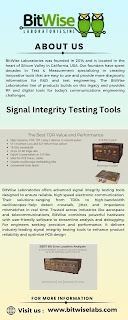How to Test PCB Traces with a TDR – A Guide by BitWise Laboratories
Looking for a reliable method to test the integrity of your PCB traces?
BitWise Laboratories brings you a practical guide on how to test PCB traces with a TDR (Time
Domain Reflectometer)—an essential technique for modern electronics testing.
Unlike traditional continuity tests, TDR offers a non-invasive and
highly accurate way to evaluate PCB trace quality. A TDR sends a fast
electrical pulse down the trace and measures the time it takes for reflections
to return. Any deviation in the expected signal can indicate faults such as
opens, shorts, impedance mismatches, or discontinuities.
Step-by-Step: How to Test PCB Traces with a TDR
- Choose the
Right TDR Equipment:
Select a TDR with suitable bandwidth and resolution based on your PCB design. High-frequency boards require high-bandwidth TDRs for accurate diagnostics.
- Connect the
TDR Probe:
Connect the probe to the trace under test. Ensure a stable and clean contact to avoid false readings.
- Calibrate the
TDR:
Perform baseline calibration to eliminate the effect of cables and connectors. This ensures the measurement reflects only the PCB trace conditions.
- Analyze the
Waveform:
Observe the reflected waveform on the TDR screen. A flat line indicates a clean trace, while spikes or dips suggest impedance issues or damage.
- Locate Faults
Precisely:
Use the time of reflection and known signal velocity to calculate the fault’s exact location on the trace.
At BitWise Laboratories, we not only offer advanced tools to test PCB
traces with a TDR but also provide expert guidance and technical support to
ensure precision in every measurement. TDR testing is a cornerstone in
high-speed PCB design verification, and our team ensures that your testing
process is seamless and insightful.
With growing complexities in circuit design, knowing how to test PCB traces with a TDR is no
longer optional—it’s essential. Trust BitWise Laboratories for all your PCB
diagnostic needs.
For more information
Visit us : https://bitwiselabs.com/




Comments
Post a Comment